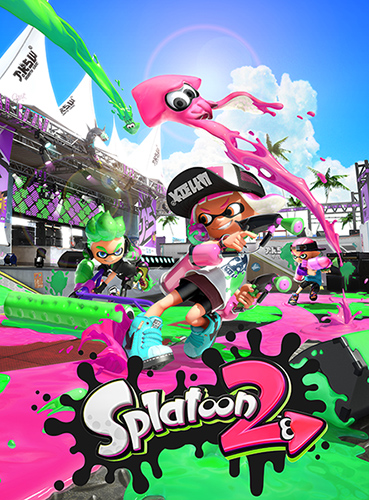Review – Splatoon 2
- By Refia
- July 26, 2017
- No Comments
Why Splatoon 2 Is a Nearly Flawless Sequel

Splatoon 2 is a sequel to the successful new Nintendo IP Splatoon created in 2015 for the Wii U. Does the sequel hold up to the gameplay that gave the original its success? In a word, yes, although there are a few things Nintendo has forgotten that they will hopefully patch later. In Splatoon, you’re a creature known as an Inkling which is both a squid and a kid: you can swim in the ink you make as a squid, and then jump out of it and walk around as a kid which allows you to shoot your weapon, which creates more ink of your color, which you can walk through, and it hinders enemy movements while in it. The fundamentals haven’t changed here, it’s very much the same basic game. But what’s different?
The first big thing different is that now there’s a co-op horde style mode called Salmon Run. This mode pits you and three other people against mechanically enhanced salmon-like creatures called Salmonids, including different random events like fog, where you can’t see very far, high tide, where your map area shrinks as the lower areas get flooded, and the mothership event, which makes you get your eggs from Salmonids with crates. It’s one of the best new additions to the game, except that you can’t level up with your friends if your rank in Salmon Run is different from them, and also the fact that it doesn’t increase your main level is a bit annoying, since your level dictates what weapons you can buy and the quality of the clothes you can get (higher levels give your clothes more ability slots, which affect gameplay). As is the case with a lot of the modes, it has something holding it back: you can only play at set times instead of whenever you want online.
Turf War, a mode where you compete to ink more ground from the other team, is largely the same, single player is pretty much the same, except that now to unlock all the weapons you have to complete every stage with every weapon. Luckily they are only skins, but for completionists like me, doing that gets very old after a while. The single player stages themselves are very well designed and it’s possibly one of the best tutorials to the game they could have ever made. The single player teaches you through gameplay things like doing tricky jumps, shooting targets of different speed, moving up to a sniper or gatling gun user while maintaining cover, bomb usage, movement, and more. There are shortcuts in a few of the levels that encourage you to play smarter, and you get to use all the major weapon types and most of the special and sub weapons. The Octoling stages pit you against AI opponents on stages you actually play in multiplayer mode so you learn the stages as you go through the campaign. It’s very clever in how it teaches you those things and most people haven’t given it enough credit that I’ve seen so this aspect is a huge upgrade from the first game.
Ranked mode is pretty much the same, although the Rainmaker is much less powerful than it was before. There are two modes that are basically king of the hill mode (one of which has a moving “hill”, and Rainmaker mode which is pretty much a capture the flag kind of mode, except the thing you have to take to your opponents’ base is also a weapon the person who grabs it can use. The ranks are stored separately, and you can play with friends once you achieve a B- rank, although it’s a bit silly you can’t do so right off the bat.
Turf War is the main unranked mode as described earlier, and it’s still pretty good, with the caveat that you can only join a game a friend is already in and you can’t just queue as a party, which means that you need to hope that the room your friend is in will have enough space for you, which can often result in a long wait time if no one leaves the game. You can queue as a team during a splatfest, but not during other times.
Local multiplayer is fine, and has the upside that you can play Salmon Run locally at any time, even when the online event is not running. This iteration has a number of quality of life improvements, like how you can eventually pick the abilities on your gear through earning ability chunks in salmon run and by scrubbing gear, which let you add an ability to a piece of clothing, but the game has a number of things that are pretty obvious features that should have been included, which hopefully will get patched. Other than the minor downsides, Splatoon 2 is a very well crafted sequel that doesn’t fix what isn’t broken, and comes highly recommended for any Nintendo Switch owner.
Score: 8/10



 ~50 Users Online
~50 Users Online Copyright © 2025
Copyright © 2025
Leave a Reply